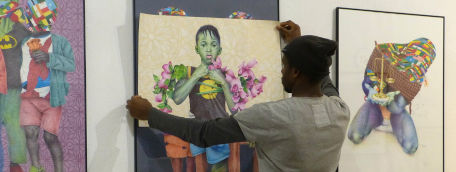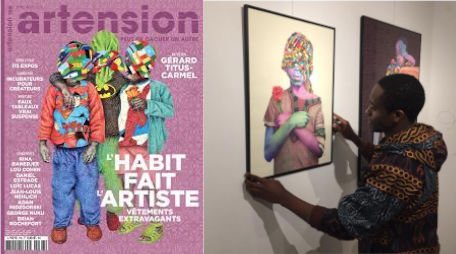About Emmanuel Aziseh :
Humanity and Humanism
Born in Bamenda (Cameroon) in 1992, Emmanuel Aziseh is one of the rising figures of African Contemporary Art. Through his colorful works with ballpoint pen and acrylic, he plunges us into the shadowy areas of our society and offers us a look at this stifled, brutalized, and sacrificed youth, but which nevertheless retains its share of dreams and vitality.

A graduate of the Beaux-Arts de Foumban, Emmanuel Aziseh has received many awards for the quality of his work and his artworks have been exhibited especially at the Vasalery Foundation, the Friche Belle de Mai, and the Karlsruhe International Art Fair.

Contemporary African Art has been showcased in recent years by numerous large institutions, museums and foundations around the world. Artists are enjoying increasing and sustained international recognition, as demonstrated by the numerous specialist trade fairs that have sprung up in Africa, Europe and the United States.
AWARDS & PRIZES
2018
- Jeune talent 2018- Public's choice- Aix-en-Provence, France
- ML'Art 2018- Public's choice- Eyguières, France
- Jeune talent 2018- First prize- Aix-en-Provence, France
2017
- Jeunes Espoir - Nominé- Lauréat- Douala, Cameroun
- Octobre rose- First prize- Aix-en-Provence, France
2016
- Mémoire d'esclaves - Third prize- Yaounde, Cameroun
2015
- Cameroon Cultural Centre- Second prize- Yaounde, France
RESIDENCE
2020
- Artists in residence - Marseille, France
SOLO SHOW
2021 - Les Enfants Autour de Nous / Galerie Polysémie - Marseille, France
2018 - Frustrated desires / Galerie Art Actuel - Béziers, France
GROUP SHOW
2020
- Art Karlsruhe / art KARLSRUHE International Art Fair - Karlsruhe, Allemagne
2019
- Et pourquoi pas? / Fondation Vasarely Aix-en-Provence - Aix-en-Provence, France
- Solid'art / La Friche Belle de Mai - Marseille, France
- Douala Art Fair / Canal Olympia Bessenguè - Douala, Cameroun
- AFRICA 3 / Galerie Polysémie - Marseille, France
2018
- Duo Exhibition / Galerie Atelier Agora - Eyguière, France
- Jeune Talent / GALERIE ESDAC - Aix-en-Provence, France
- Jeune Talent / 361° Espace d'art Contemporain - Aix-en-Provence, France
2017
- Jeunes Espoir / Espace Doual'art - Douala, Cameroun
- Mémoire Libérées / National museum - Yaounde, Cameroun
2015
- Permanent Collection Exhibit / Cameroon Cultural Centre - Yaounde, Cameroun
2014
- Rencontre théatrale Universitaire / French Institute - Yaounde, Cameroun
PERMANENT COLLECTIONS
2020
- Bernard Fabry, France
2019
- Galerie Polysémie, France
- Guy Ferrer, France
2016
- Cameroon Cultural Centre, Cameroun
- Routes des chefferies, Cameroun
PUBLICATIONS
2021
- Mathilde Mascolo- Les enfants autour de nous, à la Galerie Polysémie
2020
- Anastasia Le Goff- Aziseh Emmanuel : “Je n’expose pas mes dessins mais j’expose le spectateur face à mes dessins”
2019
- Floréal Duran- le génie du stylo à bille.
- David Tchidjé- FOCUS: AZISEH, la mine d’or inexploitée d’Afrique
2018
- Gerard Sendra- Exposition du jeune artiste Aziseh Emmanuel
2017
- Aziseh Emmanuel- …Why should we tarnish the image of a blessed country as Cameroon? The heart of Africa! The dreaml…
Aziseh Emmanuel : "I do not expose my drawings but I expose the spectator in front of my drawings".
(Anastasia Le Goff - Artistikrezo - 03/07/2020)
"First victims and at the same time future of the world, children offer as a gift the flower as a symbol of universal peace", this is what Aziseh expresses to us in her drawing Child's Heart II. With his ballpoint pen, he plunges the viewer into a form of empathy that we can feel towards these children of the world.
Hello Aziseh, can you introduce yourself in a few words?
I am originally from the city of Bamenda, in Cameroon. I have been drawing since I could hold a pen. I was fascinated by my older brother's drawings, and it was there that I cultivated this love for drawing. I entered the Institute of Fine Arts in Foumban in 2010. Since then, I mainly deal with subjects around the human being and his place in society in my drawings.
Where do you draw your inspiration?
What inspires me is our daily life. When I draw, I don't think about art but about my daily life as an artist of the world. I make other people's problems my own, feeling connected to the human community. I am inspired by those voiceless people, those young people whose dreams have been stolen, stifled, and brutalized. Artists like Kehinde Wiley inspire me, for her work with flowers that I incorporate into my backgrounds in solid colors, a technique borrowed from children who cannot capture volume. I also like Patrice Murciano's color work. The notion and meaning of color in my work are inspired by the logo of the Olympic Games created by Pierre de Coubertin in 1913. For him, the five intertwined rings expressed universality, then the logo was later reinterpreted as representing the five continents. It is from this common definition that is born the link of the color to the human being, attributing in my artistic work a color to a race, a people, or a continent, to support this idea of universality.
Childhood has a predominant place in your work. Can you tell us more about it?
I represent the world of children, which is a world I love. Sometimes I say that I make doodles. These doodles refer to our childhood for me. It's like a game reminding me of those gestures we used to do when we were little. My work evolves every day, with the facts of everyday life. In 2018 I made a drawing of a child, titled Child and the rose Flower, who is holding a rose to his chest with his arms crossed. His skin is multi-colored and clothed in a shirt. Another Our reality drawing, done in 2018, depicts four children holding each other by the shoulders. What I wrote on their shirts represents the future of these children. Between yesterday when they were slaves and tomorrow, when I wondered what they would become.
What messages do you want to convey through your drawings?
The work of children in the mines, in the cocoa fields, on the streets selling, sex slaves, and all that encompasses these injustices, that's what I wanted to show, in a different way. It's a work I've been developing since 2017, when the slave market was unveiled on the Libyan side. I saw then that children were part of these documentary videos. I asked myself, "How did they get there?", hence the title of my solo exhibition Frustrated Desires in 2018, around human trafficking. To this day, I am in search of those lost loves, dreams, passions that evaporate from souls every day due to overwhelming dominations, inviting society to free itself from dehumanizing actions, offering it a space for reflection and dialogue on daily realities.
What place do you give to your drawings?
I do not expose my drawings but I expose the spectator to my drawings. I immerse the viewer in these drawings, in a kind of empathy, inviting them to put themselves in the place of the children represented. Through these different portraits, I evoke a real humanism in the human being, by translating the state of mind of these young people whose dreams have been violated and stifled.
How did you experience this period when the world was confined?
For me, it has been both rewarding and tiring. Normally, I work a lot at home. It was surprising for me to see that with the confinement, I wanted to go out. Nevertheless, it helped me a lot to see the world differently. That's what inspires me for the work I'm building right now. The confinement rather showed how human beings are one. It makes us realize that there is no difference between men, skin color, social position, or where we are. This health crisis has reduced us to something similar, showing that in the end, we human beings are one, and that we are not different from the one in front of us. This brought me back once again to the original meaning of my work, where color represents for me who is in front of us, a continent, a race. Every time you see a blue in my drawing, you know it's about Europe, black for Africa, yellow for Asia, and red for America. During this period, I saw the more human and solidary side of men. And for me, this has not stopped. The confinement helped me and made me see my work differently. Since then, I have been developing work that is a little different from what I am used to doing, with acrylics and no longer with a pen.
Do you have any advice to give to those who would like to start drawing?
If I have one piece of advice to give, it is work, always work. I remember when I was at the Institute of Fine Arts in Foumban, I had just arrived in my first year, I had friends who had done a secondary art school in Cameroon. They were already very talented in painting and I was amazed to see that it was young people like me who were doing such wonderful things. I didn't worry about it, I already knew the technique of drawing because I had reproduced a lot of them. But with people who were already ahead of me, with studies mainly in art, I had approached them saying to myself that I had a lot to learn. I painted with them throughout my years of study. What satisfied me was when they told me that I painted like this person. I went from studio to studio to be able to work, that's why for me it's the work and humility that are important. You have to be humble, to be in the spirit of always wanting to learn from others. After learning, you have to bring it back to yourself and think about how you can use these different techniques that you have seen in other people.


















